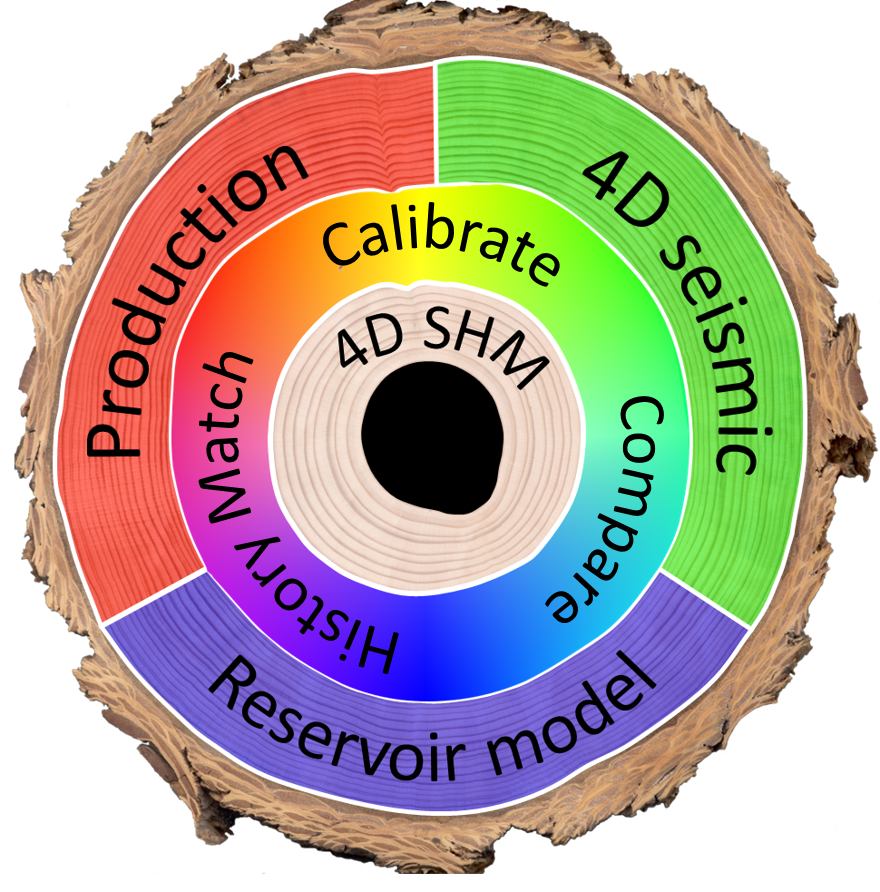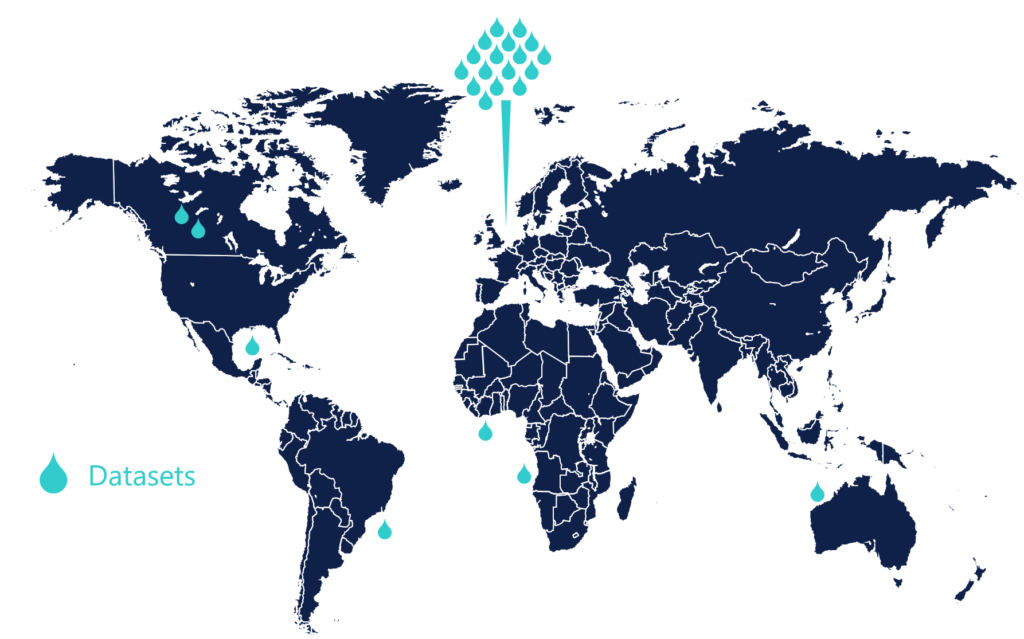Research

In the early 1990’s 4D seismic analysis evolved rapidly as a qualitative tool for identifying in-fill opportunities, and this laid the foundation for establishing solid business value. Indeed, the 4D seismic method became the first seismic technology to be favourably quoted in The Financial Times. As confidence grew over the following two decades, more quantitative value was extracted through the interpretation of mapped post-stack amplitudes or inverted impedances (or VP/VS), inversion to pressure and saturation changes using pre-stack amplitudes, and the use of post-stack time-shift analysis. Such information can provide an 80% solution that delivers value by improving recovery through better quality production and development decisions. It also allows direct updating of the simulation model – to adjust volumes (STOIP, porosity, NTG), connectivity (permeability, transmissibility multipliers), barrier/fault positioning and even top reservoir. Many good examples also now exist, not only at the field and sector level but at the local well scale, to demonstrate that 4D seismic data helps to improve or manage individual well performance and productivity. Indeed, it is possible for perforation performance or producing flow units to be assessed to provide critical guidance to the reservoir and production engineer (for example, van Gestel 2014). These many developments have been made possible by improvements over the years in the quality of the acquisition repeatability (with NRMS values of less than 20% now being an acceptable benchmark for 4D projects), the increase in frequency with which the surveys are shot from tens of years to one or two years, and a significant advance in our understanding of how to make best use of such repeated signals.
In current times however, the industry faces a new challenge of how to provide more information for less cost. When oil prices remain low for extended periods, an emphasis must be made on reducing the cost of 4D surveys and improving the return on any investment made in acquisition, processing and interpretation using existing contracted data. It is recognized by many that an integrated approach drawing from a broad range of technologies including 4D seismic, subsidence data, gravity, magnetics is one approach for tackling this problem. Also there appears an even greater need to explore multi-disciplinary solutions to enhance the information content from the acquired 4D seismic data. As highlighted at the 2016 SEG workshop, the theme of realizing more value with the seismic data requires a thorough inter-disciplinary and integrated interpretation, and solutions that are more fit-for-purpose. In addition there is a need to deliver immediate and relevant value straight to the asset. Thus, 4D seismic data needs to be quickly assimilated into the reservoir management work cycle, and this in turn places demands on the time taken to acquire, process, interpret and assimilate the data. Research is required into how to best analyse the data to handle the necessary model updates with an increasingly short turnaround whilst still retaining accuracy relative to the more classical routes of solving this problem. This emphasis on integration, multi-disciplines, and speed is already a key element of ETLP research.
In extracting more value, pre-stack analysis has been under considerable attention. It is now recognized that post-stack amplitude interpretation is now mature, having been successfully applied for over twenty years. Such interpretation is simple yet effective, works exceptionally well in the operational environment and has returned many acknowledged benefits for assessing well performance and dynamic reservoir management. However despite this success challenges remain such as in thick complex reservoir or recovery mechanisms such as water alternating gas (WAG). The role of pre-stack amplitudes also remains an area to be investigated. It is routine practice to evaluate post-stack time-shifts – measured as two-way time differences between time-lapse seismic vintages both inside the reservoir and the surrounding rocks. Post-stack time shifts allow us to monitor strain changes in the overburden for active geomechanical reservoirs (and occasionally the underburden), and to invert for pore pressure changes. Post-stack time-shift analysis has become increasingly popular over the past ten years, however perhaps the potential has still not yet been fully realised. There is a current push/trend to move to pre-stack, which is the natural direction for time-shift science and may well be founded on good reasons based on some of the challenges raised from the post-stack world. Early evaluation of pre-stack time-shift data determine that there is potential, however results lack robustness and practicality. With the emergence of the popular full-wave imaging techniques or its variants, such techniques may circumvent the need to worry about amplitude and time-shifts explicitly. In terms of a practical 80% solution it is likely that post-stack time-shift analysis hits the mark in many cases, but we do need to see an improvement in data quality to add clarity to our results. The recent 2017 EAGE workshop on ‘Pre-stack quantitative analysis of 4D seismic data’ highlighted the need to explore the world of pre-stack more effectively, and both encouraged and challenged participants to push further into this area of research.
Finally, one over-arching principle has been identified by our sponsors during our various meetings – the need to specify uncertainties. This is true for the 4D seismic analysis, when describing different domains, workflows, and also with the seismic history match regardless of whether this is a direct update, wiggle trace, impedance domain, pressures and saturations, time shifts, or when utilizing the binary or ternary approach. Flags to understand the quality of the data input into the seismic history matching are of utmost importance. The use of error models to compare and evaluate our results remains a challenge in all of our modules. The pro and cons of using existing method of uncertainty analysis for 4D seismic analysis remains undeveloped, and therefore we hope to demonstrate further more advanced treatment of uncertainties over the next three years.
ETLP is well placed to capitalise on the developments defined above, having identified a number of key research threads in the project evolution from Phase I to Phase VI, which if progressed will continue to derive major benefits in the way we work with time-lapsed seismic data. These build on key advances made by our research team over the past eighteen years as outlined on the following page:
• Basic 4D seismic interpretation strategies
• Seismic geomechanics – warping, time-shift analysis, pressure inversion
• Petroelastic model – calibration, pressure sensitivity, appropriate PEM
• Pressure and saturation inversion – EC constraints, chalks, clastics
• Sim2seis – modelling, PEM, …
• Shales – diffusion and geomechanics, geological description
• 4D impedance inversion – with EC constraints, various case studies
• Reservoir connectivity – well2seis, well2well, seis2seis
• Seismic history matching/updating strategy – workflows, seis2sim
All of the above are investigated within the framework of assorted field case studies for chalk, hard rock carbonates and clastic reservoirs, with light to heavy oil, and a range of production mechanisms.
We view our Phase VII work as directly addressing the new ‘more for less’ and ‘pre-stack’ environment. We continue to explore and consolidate quick and efficient ways of reservoir model updating through direct or history-match procedures using our ever increasing stable of algorithms. In the updating, we look specifically at the issues of speed of turnaround as we acknowledge that conventional history matching process is time consuming and yields non-unique answers. We find ways to better pursue the match to the seismic and in particular suitable seismic attributes to provide adequate match. With our current balance of geoscientists and engineers in the student and staff complement, we believe we have the expertise to address some exciting issues over the coming three years.

